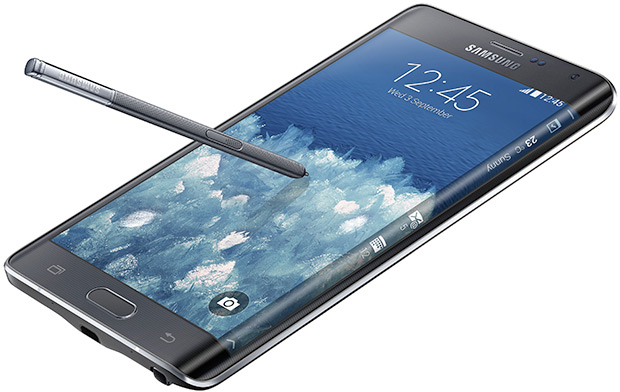Samsung Galaxy Note Edge Review
Introduction and Specifications
We applaud companies willing to push the envelope with innovative new design approaches. Sometimes their efforts aren't rewarded with complete market acceptance, but unique features and hardware that attempt to blaze new trails in existing markets, are always interesting to say the least. In a way, the Galaxy Note Edge fits this description. Similar to 4K curved televisions, one has to wonder if the world truly needs a flagship smartphone with 160 extra pixels along its right edge with an additional curved display. But, as was the case when the original Note launched and many experts shook their heads in disapproval, the Note Edge could strike a chord with consumers and usher in a new wave of similar devices. Time will tell.

The Galaxy Note Edge is, by and large, a Galaxy Note 4 (you can read our review of that beast right here) with a slightly different form factor. Almost everything on the inside is identical to the company’s latest phablet, and even the exterior cues are very similar. The only notable differences are the size (the Note Edge checks in a few millimeters smaller) and its display. With the Note Edge, Samsung has managed to roll the right edge of the panel all the way down to where the screen meets the rear backing of the device, creating an infinite edge of sorts that is truly differentiated from any other phone on the market. You want unique? This is it.
There’s more than great design to gawk at, as the internal spec sheet is about as stout as you can get at the present time. Here’s a look at what powers the Note Edge.
If you compare the above to what’s inside the Galaxy Note 4, you won’t find too many differences. Both phones offer similar performance and size, but the Note Edge has an exclusive curved screen that gives users the ability to view notifications and other info just by glancing at the edge, without opening up a flip cover or case. However, the Note 4 is $100 cheaper, and is available across more carriers (the Note Edge is reserved for AT&T in the United States). We’ll do our best to break things down in the pages ahead, however, to see if there are any more noteworthy differences.

The Galaxy Note Edge is, by and large, a Galaxy Note 4 (you can read our review of that beast right here) with a slightly different form factor. Almost everything on the inside is identical to the company’s latest phablet, and even the exterior cues are very similar. The only notable differences are the size (the Note Edge checks in a few millimeters smaller) and its display. With the Note Edge, Samsung has managed to roll the right edge of the panel all the way down to where the screen meets the rear backing of the device, creating an infinite edge of sorts that is truly differentiated from any other phone on the market. You want unique? This is it.
There’s more than great design to gawk at, as the internal spec sheet is about as stout as you can get at the present time. Here’s a look at what powers the Note Edge.
|
| OS |
Android 4.4.4 (KitKat) |
| CPU |
Qualcomm Snapdragon 805 processor with 2.7GHz quad-core CPU |
| GPU |
Adreno 420 |
| Memory |
32GB & 64GB |
| Screen |
5.6” Quad HD+ Super AMOLED (2560 X (1440+160)) 16:9 aspect ratio Corning Gorilla Glass 3 |
| Rear Camera |
16MP with "Smart optical image stabilization" LED Flash |
| Front Camera |
3.7MP HD Video Conferencing |
| Audio Output |
Single rear speaker |
| Network |
2.5G (GSM/GPRS/EDGE) : 850/900/1800/1900 MHz 3G (HSPA+ 42Mbps): 850/900/1900/2100 MHz 4G (LTE Cat.4 150/50Mbps) or 4G (LTE Cat.6 300/50Mbps) |
| Wireless |
Wi-Fi 802.11 a/b/g/n/ac (2X2 MIMO) Download Booster, NFC, Bluetooth® v 4.1 (BLE),ANT+ , IR LED (Remote Control) |
| Ports |
Micro USB 2.0 MHL 3.0 Nano SIM 3.5mm audio |
| Sensors |
Gesture, Accelerometer, Geo-magnetic, Gyroscope, RGB ambient light, Proximity, Barometer, Hall Sensor, Finger Scanner, UV, HRM |
| Size |
151.3 x 82.4 x 8.3 mm |
| Weight |
174g |
| Color |
Charcoal Black |
| Battery |
3000mAh, fast charging Standby time (Ambient Display on) up to 14.3 days Talk time up to 22.4 hours |
| Price |
AT&T Exclusive in United States $945.99 (off-contract) for 32GB $399.99 (with 2-year contract) for 32GB |
If you compare the above to what’s inside the Galaxy Note 4, you won’t find too many differences. Both phones offer similar performance and size, but the Note Edge has an exclusive curved screen that gives users the ability to view notifications and other info just by glancing at the edge, without opening up a flip cover or case. However, the Note 4 is $100 cheaper, and is available across more carriers (the Note Edge is reserved for AT&T in the United States). We’ll do our best to break things down in the pages ahead, however, to see if there are any more noteworthy differences.






